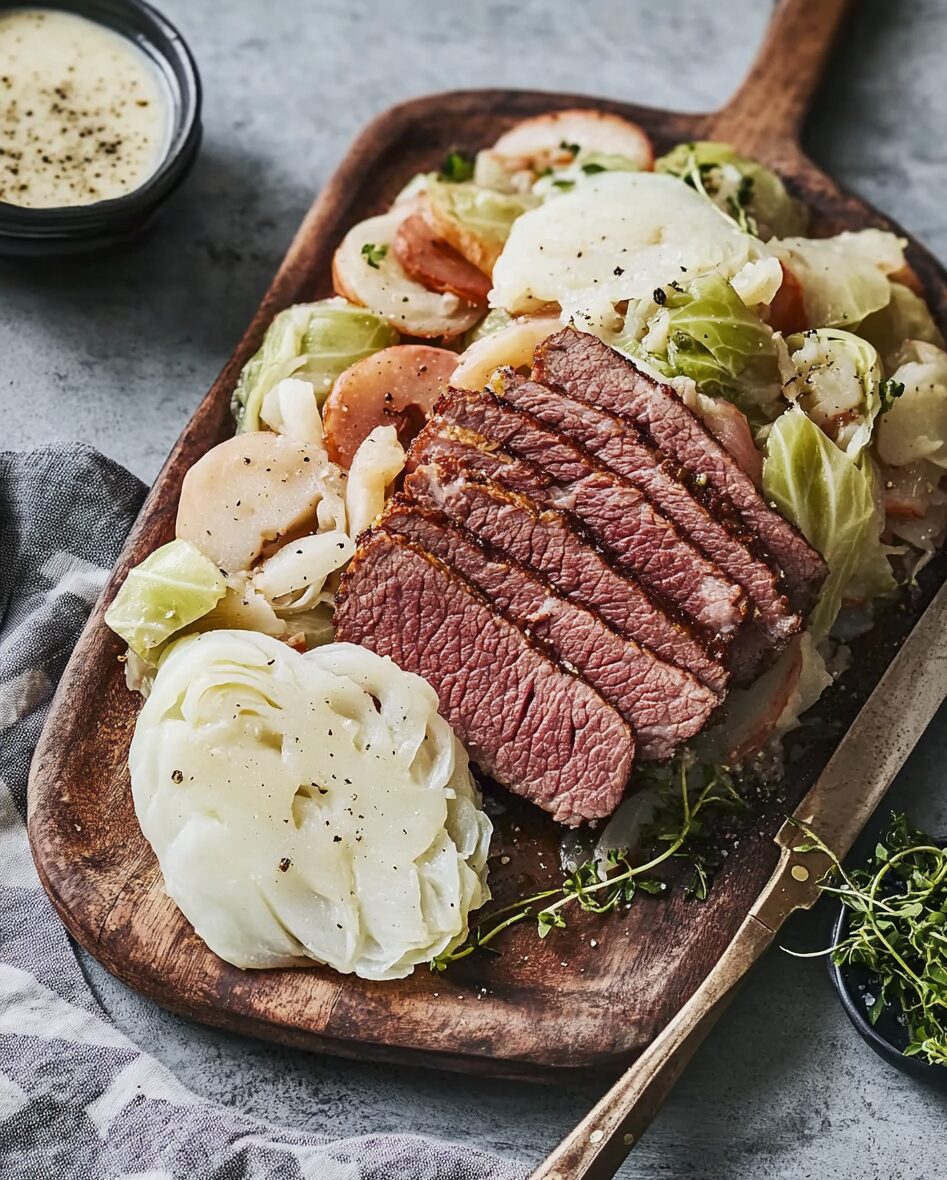Corned Beef and Cabbage is a beloved dish that marries tender, flavorful beef with hearty vegetables like potatoes, carrots, and cabbage. It’s a comforting, one-pot meal that is as satisfying as it is traditional. The corned beef brisket is slowly simmered with the spices to infuse deep, rich flavors, while the vegetables cook to tender perfection in the same pot, soaking up all the savory goodness.
This dish is a staple in many homes during festive celebrations like St. Patrick’s Day, but it’s perfect for any day when you want a warm, cozy, and complete meal. Whether served family-style in the center of the table or plated individually, Corned Beef and Cabbage is sure to bring a comforting touch to your dinner table.
Full Recipe:
Ingredients:
- 1 (3-pound) corned beef brisket with spice packet
- 10 small red potatoes
- 5 carrots, peeled and cut into chunks
- 1 large head of cabbage, cut into wedges
Directions:
- Place corned beef in a large pot or Dutch oven and cover with water. Add the spice packet that came with the corned beef. Cover the pot and bring to a boil, then reduce to a simmer. Allow the beef to cook for approximately 50 minutes per pound, or until tender.
- Add the potatoes and carrots, and cook until just tender, about 20-25 minutes.
- Add the cabbage wedges and cook for an additional 15-20 minutes, until the vegetables are tender and cooked through.
- Remove the meat and let it rest for a few minutes. Slice against the grain and serve alongside the cabbage, potatoes, and carrots.
Prep Time: 15 minutes | Cooking Time: 3 hours | Total Time: 3 hours 15 minutes
Kcal: 839 kcal per serving | Servings: 5 servings
Origins of Corned Beef and Cabbage
Corned Beef and Cabbage is often thought of as a traditional Irish dish, but its history is a blend of Irish and Irish-American influences. While the Irish have long eaten salted or “corned” meats, the version we know today has deep roots in the immigrant experience in America, particularly during the 19th and early 20th centuries.
In Ireland, pork, particularly bacon, was more commonly consumed than beef due to the economic structure of the time. When Irish immigrants arrived in the U.S., especially in cities like New York, they found beef to be more affordable and accessible than pork. The Irish adapted their traditional boiled bacon and cabbage recipe by substituting it with corned beef, which was readily available in Jewish delis and markets. This led to the creation of the iconic Corned Beef and Cabbage meal, a symbol of Irish-American culture, particularly associated with St. Patrick’s Day celebrations.
Tips for Making the Perfect Corned Beef and Cabbage
- Choosing the Right Cut: Corned beef is typically made from beef brisket, which comes in two cuts: point cut and flat cut. The flat cut is leaner and slices more evenly, making it a popular choice for serving. The point cut, though fattier, can be more flavorful and tender. Choose the one that fits your preference.
- Rinse the Brisket: Many corned beef briskets are sold pre-brined and come with a spice packet. Before cooking, it’s a good idea to rinse the meat under cold water to remove excess salt from the brining process. This prevents the dish from becoming overly salty.
- Cooking Low and Slow: Corned beef is best cooked using slow, moist heat methods like simmering or braising. This allows the tough brisket to break down into tender, flavorful meat. A low simmer over 2.5 to 3 hours is ideal. Avoid boiling too vigorously, as this can toughen the meat.
- Timing the Vegetables: For perfectly cooked vegetables, add them at different stages. Potatoes and carrots can be added about 45 minutes before the corned beef is done, allowing them to become tender without overcooking. Cabbage, which cooks more quickly, should be added during the last 15 minutes.
- Resting the Beef: After removing the corned beef from the pot, allow it to rest for about 10 minutes before slicing. This helps the juices redistribute within the meat, ensuring a moist, flavorful slice. Always slice against the grain for the most tender texture.
- Flavor Enhancers: While the spice packet that comes with the corned beef is sufficient for seasoning, you can enhance the flavor by adding extra whole spices like bay leaves, peppercorns, cloves, or mustard seeds to the pot. For a deeper flavor, some people also like to add a splash of beer or broth to the cooking liquid.
- Serving Suggestions: Corned Beef and Cabbage is often served with a side of mustard or horseradish to add a bit of bite to the meal. A hearty Irish soda bread or rye bread can also complement the dish beautifully. For leftovers, you can repurpose the corned beef into sandwiches, hash, or even soups.
- Making It Your Own: Though the dish is traditionally boiled, you can experiment with other cooking methods like roasting the brisket after it’s simmered to create a crispy outer layer. You can also mix and match vegetables like turnips or parsnips for a slightly different take on the classic dish.
Nutritional Value and Health Tips
Corned Beef and Cabbage is a hearty, protein-rich meal, but because it’s made with cured beef, it can be high in sodium. To manage the salt content, you can soak the corned beef in water overnight before cooking to draw out some of the excess salt.
Cabbage and other vegetables in the dish are high in vitamins and fiber, making them a healthy addition to balance the richness of the meat. To lighten the meal, serve smaller portions of the corned beef and fill the plate with more of the vegetables.
Conclusion
Corned Beef and Cabbage is a flavorful, hearty dish that beautifully blends Irish heritage with American adaptations. Its origins highlight the resourcefulness of Irish immigrants, who transformed a traditional meal into something uniquely their own. Slow-cooked to tender perfection, this dish is ideal for family gatherings or holiday celebrations, particularly around St. Patrick’s Day.






